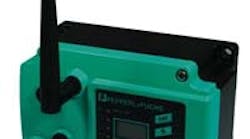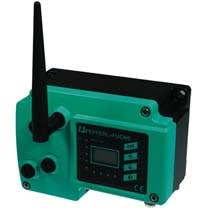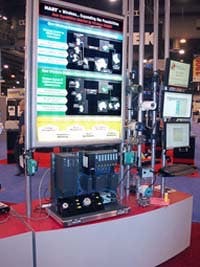Many chemical plants are abuzz with talk about using wireless technology. The noise is apt to get louder now with the launch of a new wireless protocol for HART devices. After all, 23 million to 25 million HART devices are installed globally, with about 40% used by the process industries, notes Ron Helson, executive director of the HART Communi-cation Foundation, Austin, Texas. The new WirelessHART protocol is backward-compatible with existing HART devices and applications.
Helson understandably applauds the wireless-mesh-network communications pro-tocol. It represents a major step for the industry, he says. Weve defined it in terms of what users know and love about HART devices. The new specification, a key part of the HART Field Communications Protocol Revision 7, was approved June 15 by the HART Users Group.
With proper installation, I would think WirelessHART would be quite successful in doing its job, believes Hesh Kagan, president of the Wireless Industrial Networking Association and also director of technology development and new-business development for Invensys Process Systems, Foxboro, Mass. By definition, its a process measurement tool, he says. Now the question is: How many process measurements are going to be incremental, based on wireless sensors or WirelessHART?
Figure 1. Working prototypes of this gateway have been released.
For process automation, it represents wireless communications future, believes Guido Stephan, director of technology and processes within Siemens Research & Devel-opments Technology & Processes group, Karlsruhe, Germany. Our conclusion is that WirelessHART will become a standard.
Pepperl+Fuchs (P+E) is very excited about the new protocol, says Robert J. Schosker, product manager for intrinsic safety, HART, at the firms Process Automation Division, Twinsburg, Ohio, calling it the first standard for a wireless network in the process automation area. I believe WirelessHART now gives the user added flexibility in installation and helps give those riding the fence that extra push to get them to use HART, he adds.
Key features
Wireless HART comprises three distinct parts, explains Kagan. One is the radio, which many manufacturers can provide. The second is the stack, which handles the physical, data-link and network layers. Finally, theres the protocol, which he calls the handshake between the applications and the systems a data frame out of the HART 7.0 standard.
Helson cites two particularly noteworthy attributes. The physical and data-link layers adhere to the 2.4-GHz IEEE 802.15.4 Low-Rate Wireless Personal Area Network standard, and wireless mesh networking forms the network layer. The specification has a full-mesh topology, meaning each device connects to all others, directly or through other devices.
Stack definition owes a lot to Dust Networks, Berkeley, Calif. It includes much of the firms proprietary Time Synchronized Mesh Protocol (TSMP), used in ultra-low-power wireless sensor networking, notes Joy Weiss, Dust Networks CEO. TSMP helps the protocol provide wire-like reliability in a harsh environment on which the devices will have to operate in, but in a wire-free economy, Weiss explains.
WirelessHART also includes several features that are essential for wireless of any type to take hold, adds Robert Shear, Dust Networks director of market development. Those include channel hopping, self-organizing mesh and time synchronization. The lat-ter unlocks the economics for the new specification, he says. You end up with the ability to have battery-powered routers allowing frequency hopping.
The fact that there are batteries contributes to the low initial cost, explains Weiss. The highest cost element [in wired automation systems]: Its still cable and con-duit and the time associated [with installation] and the disruption associated with a plant [through that installation].
Potential users certainly will value two attributes highly, notes Martin Zielinski, director of HART and Fieldbus Technology for Emerson Process Management, Austin, Texas reliability and coexistence, or the capacity of the wireless bands to carry traffic from various transmitters.
Immediate value
Many plants in the huge installed base of control systems using wired HARTs 4-20-mA loop lack the economic justification or technical capability to access HART devices in-telligent information. WirelessHART will significantly change that, Helson predicts.
We tried to make it as easy as 420 mA, by extending the protocol with a view to allowing use of similar tools: self-building, self-healing networks and minimal engi-neer input, explains Gareth Johnston, fieldbus-communications specialist with ABB, St. Neotts, U.K., who helped develop it.
End-users who understand the benefits of asset management will embrace Wire-lessHART, believes Dave Smith, manager, plant-network-technology systems marketing for Yokogawa of America, Newnan, Ga. Its a solution adding digital communication for device configuration and/or various prognostic/diagnostic functions provided by intel-ligent field devices with minimum or no changes to control configuration.
It fits well with maintenance and asset management strategies, adds his col-league Nobuaki Konishi, senior general manager of IA Marketing Division, Yokogawa Electric, Tokyo. He foresees a definite role for the new protocol for monitoring and alarming.
Two early asset-management applications come to mind to Siemens Stephan. One is transport of field-device diagnostic data. Thats because in the installed base, precious diagnostic data. . . is lost in about 20 million devices, or must be read manually due to a lack of HART functionality in the remote I/Os (inputs/outputs), he notes. The other: complete wireless integration of process values and diagnostic data of field devices.
Zielinski also expects WirelessHART to excel for bringing in now-stranded diag-nostic information. Of the millions of installed devices, about 2 million digitally com-municate, he estimates. For the rest, WirelessHART provides an add-on to communi-cate digital information back to the asset management system. Up until now, with the 420-mA loop and no wireless capability, the field technician had to go out with a handheld communicator, he notes.
The protocol also allows engineers to monitor more points to improve processes efficiency, Zielinski adds. This is process improvement, in routine maintenance and the ability to track devices.
However, some argue that the protocol may not be the way to attain the fullest as-set-management potential. Jeff Becker, global business director for Honeywell Process Solutions, Phoenix, is skeptical. When you look at the plant-wide wireless needs beyond stranded device diagnostics and the limited wireless bandwidth available, there are better plant-wide alternatives, such as SP100, available, he says.
Potential limitations exist. Even though the 2.4-GHz bands are open [world-wide], there are different implementations in different areas due to signal strength, Zielinski notes. And Johnston points out the trade-off between battery life and data-transmission rate. However, engineering tools and layout planning can help increase the battery life, as will expected improvements in battery technology, he stresses.
First adopters
Helson predicts that oil-and-gas and large chemical complexes will lead the way. Com-panies such as British Petroleum seem to be clamoring for wireless devices. They spoke at one of our meetings and said theyre anxious to get this.
ABB and P+E agree. Oil-and-gas companies have been very keen to pilot wire-less technology and help make the early technology decisions, Johnston reports. Annual shutdowns will drive petrochemicals [into] being first adopters, Schosker suggests. With wireless, they can add HART without touching the existing wiring they can do it on their time, and get their plant back in full swing and then work on HART.
Zielinski, while noting that WirelessHART wont be restricted to any industry, sees a pioneering role for companies with money to spend which means to him those in oil and gas, and perhaps also pharmaceuticals.
A potential competitor
However, some firms may deliberately wait to see what comes out of ISA, Research Tri-angle Park, N.C. And they will use ISA [SP]100, not WirelessHART, expects Richard H. Caro, CEO, CMC Associates, Acton, Mass.
SP100 does have a very broad scope, says Zielenski, who is also SP100s manag-ing director. [But] release 1 [ISA SPA.100.11a] is very similar to the field of application of WirelessHART. Right now, were very, very compatible with WirelessHART.
Theyre both optimized for battery-powered field instruments, explains Becker. They trade off the higher bandwidth of IEEE 802.11 [wireless local-area-network stan-dard] for lower power consumption, better scalability and better reliability and noise-rejection qualities. And both have similar features designed to improve reliability and co-existence, he adds.
But theyre different. WirelessHART is designed to be a single-purpose dedicated network to transport HART data primarily diagnostic wirelessly, Becker notes. SP100.11a is designed, though, to be a universal standard that simultaneously supports multiple protocols. Besides HART, some he mentions include OPC, Foundation Fieldbus and Profibus.
Figure 2. Demonstration units have appeared at several trade shows.
The two wireless contenders have similar implementation costs, says Becker, and Honeywell believes the efficiency of transporting HART data is similar for the two. However, Becker sides again with SP100. We believe it provides more value to custom-ers, even if only HART over SP100 wireless is implemented.
Reaffirming SP100s primary standing with Honeywell, he says the company in-tends to migrate our XYR-6000 family of wireless transmitters to the SP100 stan-dard initially because it is more universal.
Johnston thinks harmony is possible because of the new HART protocols design and coexistence features. WirelessHART and SP100 instrument networks will coexist in the same radio environment, he declares, adding its likely that a WirelessHART gate-way to the SP100 plant network will be developed in the future.
How this all will shake out remains uncertain. Schosker undoubtedly speaks for many users and vendors when he says P+F strongly hopes that just one standard will exist for process automation We want to avoid a wireless war similar to the fieldbus war. That ended with a standard (IEC 61158) incorporating rather than reconciling the competing protocols.
Wait until next year
No WirelessHART products currently exist because we need to rationalize comments, says Helson. That will lead to a framework for companies to build products, he adds. Youll probably start to see WirelessHART-enabled products in early 2008.
Helson anticipates that one early and important device will be an add-on, a slap-on, for existing wired HART devices to establish a new wireless path to asset-management-type applications without disturbing the 4-20 mA signal. Then therell be gateways, he expects.
Pepperl+Fuchs has released working prototypes of a HART gateway (Figure 1), Schosker notes, adding this doesnt represent a shift in the companys strategy. WirelessHART gives us just another tool to help our customers and find a solution to their need.
Emerson will broaden the role of PlantWeb, a real-time control-and-asset-management architecture, Zielinski says. ABB will continue to develop self- and outside-powered wireless devices process transmitters for instrumentation and others for condition monitoring, Johnston notes. Suggesting silicons availability will affect product releases, he reckons product to be available early 2008.
Invensys has supported HART for quite a while and will continue to support HART as wireless communications, comments Brian Courchesne, marketing manager with Invensys Performance Services, Foxboro, Mass. Yokogawa is looking at Wireles-sHART sensors, environmental sensors that differ from existing process monitoring sen-sors and gateways, Smith says.
Siemens has exhibited WirelessHART demonstration field devices at the 2006 ISA Expo and 2007 Interkama shows (Figure 2). It seems so far that customers are in-terested in getting some more experience with the new technology, step by step, Stephan notes.
Honeywell will offer WirelessHART, if customers request it, of which we have seen little indication of this to date, Becker says.
Besides new products, education is important to the protocols success. Zielinski points to the inevitable learning curve and the need to share insights. The information the buy-it-and-try-it people [will] have learned and their confidence in WirelessHART has to become common knowledge across the board. Helson agrees. Were going to need to educate users, to overcome their fears and concerns about wireless-enabled field devices. Even end-users who think theyre familiar with HART should take another look, advises Shear.
Untethered prospects
Weiss counsels the curious to try WirelessHART. If it sounds too good to be true, it is true here. She also encourages those who used wireless years ago and said it didnt work very well to try wireless again. Itll be a new experience. Try it, youll like it.
Becker says the big promise of wireless is to simply make the plant more safe, efficient and reliable. It is an enabling technology that opens many new doors. Helson, with WirelessHART specifically in mind, certainly agrees. It will open a lot of new doors, to help [companies] run their plant better, to keep their plant competitive.




